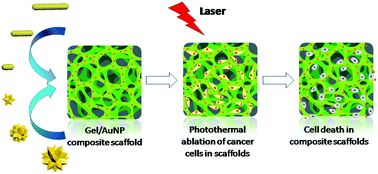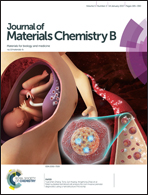Composite scaffolds of gelatin and gold nanoparticles with tunable size and shape for photothermal cancer therapy†
Abstract
Photothermal therapy (PTT) has been extensively investigated as a promising strategy for cancer therapy. For successful application of this technique, various nanomaterials have been explored as photothermal conversion agents. Gold nanoparticles (AuNPs), especially Au nanorods and Au nanostars, have received much attention for photothermal therapy because of their facile preparation and high photothermal conversion efficiency. Due to the limited accumulation and easy diffusion of free nanoparticles, incorporation of nanoparticles into scaffolds for direct implantation has been demonstrated as an attractive way for cancer therapy applications. In this study, composite porous scaffolds of gelatin and AuNPs were prepared by introducing Au nanorods and Au nanostars with average sizes of around 35.0, 65.0 and 115.0 nm in gelatin scaffolds. The composite scaffolds were used for the localized PTT application of cancer cells. Gel/AuNP composite scaffolds supported cell adhesion and showed good biocompatibility. Temperature in the composite scaffolds increased quickly upon NIR laser irradiation. Photothermal efficiency and cancer cell killing efficiency were dependent on the shape, size and amount of AuNPs in the composite scaffolds. The composite scaffolds prepared with 65.0 nm Au nanorods showed the highest photothermal efficiency and cell killing efficiency. The results indicated the importance of the shape and size modulation of AuNPs for photothermal therapy applications.

- This article is part of the themed collection: 2017 Journal of Materials Chemistry B HOT Papers


 Please wait while we load your content...
Please wait while we load your content...